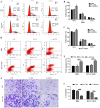HOXD10 acts as a tumor-suppressive factor via inhibition of the RHOC/AKT/MAPK pathway in human cholangiocellular carcinoma
- PMID: 26260613
- PMCID: PMC4564083
- DOI: 10.3892/or.2015.4194
HOXD10 acts as a tumor-suppressive factor via inhibition of the RHOC/AKT/MAPK pathway in human cholangiocellular carcinoma
Abstract
HOXD10, a key regulator of cell-differentiated phenotype maintainence, has been demonstrated to be involved in the tumorigenesis of many human malignacies. However, the status of HOXD10 expression and its biological function in cholangiocellular carcinoma (CCC) remain to be clarified. In the present study, we investigated the clinical significance and biological functions of HOXD10 in CCC and found that the expression of HOXD10 and its downstream effector RHOC was significantly different in well-differentiated CCC tissues compared with poorly-differentiated lesions. We also observed a significant correlation between low HOXD10 and high RHOC expression levels and worse prognosis. The stable overexpression of HOXD10 by lentivirus vector significantly inhibited cell invasion partly by downregulating the expression of MMP2 and MMP9, and significantly increased early apoptosis in CCC cell lines and induced G1 phase cell cycle arrest, contributing to the inhibition of cell proliferation in vitro. Additionally, we demonstrated that the inactivation of the RHOC/AKT/MAPK pathway was involved in the tumor-suppressive functions of HOXD10 in CCC. These results suggested that HOXD10 may be a putative suppressor gene and can act as a prognostic marker and potentially a novel therapeutic target for CCC.
Figures




Similar articles
-
Epigenetic inactivation of HOXD10 is associated with human colon cancer via inhibiting the RHOC/AKT/MAPK signaling pathway.Cell Commun Signal. 2019 Jan 25;17(1):9. doi: 10.1186/s12964-018-0316-0. Cell Commun Signal. 2019. PMID: 30683109 Free PMC article.
-
miR-10b promotes cell invasion through RhoC-AKT signaling pathway by targeting HOXD10 in gastric cancer.Int J Oncol. 2012 May;40(5):1553-60. doi: 10.3892/ijo.2012.1342. Epub 2012 Jan 24. Int J Oncol. 2012. PMID: 22293682
-
MicroRNA-10b promotes nucleus pulposus cell proliferation through RhoC-Akt pathway by targeting HOXD10 in intervetebral disc degeneration.PLoS One. 2013 Dec 20;8(12):e83080. doi: 10.1371/journal.pone.0083080. eCollection 2013. PLoS One. 2013. Retraction in: PLoS One. 2023 Mar 29;18(3):e0283113. doi: 10.1371/journal.pone.0283113. PMID: 24376640 Free PMC article. Retracted.
-
Knockdown of RHOC by shRNA suppresses invasion and migration of cholangiocellular carcinoma cells via inhibition of MMP2, MMP3, MMP9 and epithelial-mesenchymal transition.Mol Med Rep. 2016 Jun;13(6):5255-61. doi: 10.3892/mmr.2016.5170. Epub 2016 Apr 22. Mol Med Rep. 2016. PMID: 27108649
-
Role of homeobox d10 gene targeted signaling pathways in cancers.Pathol Res Pract. 2023 Aug;248:154643. doi: 10.1016/j.prp.2023.154643. Epub 2023 Jun 22. Pathol Res Pract. 2023. PMID: 37406379 Review.
Cited by
-
Formin-like 3 regulates RhoC/FAK pathway and actin assembly to promote cell invasion in colorectal carcinoma.World J Gastroenterol. 2018 Sep 14;24(34):3884-3897. doi: 10.3748/wjg.v24.i34.3884. World J Gastroenterol. 2018. PMID: 30228782 Free PMC article.
-
Identification of HOXD10 as a Marker of Poor Prognosis in Glioblastoma Multiforme.Onco Targets Ther. 2021 Oct 27;14:5183-5195. doi: 10.2147/OTT.S336225. eCollection 2021. Onco Targets Ther. 2021. PMID: 34737577 Free PMC article.
-
Restoring HOXD10 Exhibits Therapeutic Potential for Ameliorating Malignant Progression and 5-Fluorouracil Resistance in Colorectal Cancer.Front Oncol. 2021 Nov 1;11:771528. doi: 10.3389/fonc.2021.771528. eCollection 2021. Front Oncol. 2021. PMID: 34790580 Free PMC article.
-
The effect of overexpression of the HOXD10 gene on the malignant proliferation, invasion, and tumor formation of pancreatic cancer cell PANC-1.Gland Surg. 2020 Apr;9(2):385-391. doi: 10.21037/gs.2020.03.28. Gland Surg. 2020. PMID: 32420263 Free PMC article.
-
Frequent promoter methylation of HOXD10 in endometrial carcinoma and its pathological significance.Oncol Lett. 2020 May;19(5):3602-3608. doi: 10.3892/ol.2020.11467. Epub 2020 Mar 19. Oncol Lett. 2020. PMID: 32269635 Free PMC article.
References
-
- Cillo C. HOX genes in human cancers. Invasion Metastasis. 1994–1995;14:38–49. - PubMed
Publication types
MeSH terms
Substances
LinkOut - more resources
Full Text Sources
Other Literature Sources
Miscellaneous

